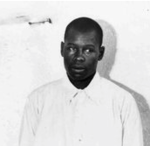 Montgomery Archives Two white females, Victoria Price, age 21, and Ruby Bates, age 17, both mill workers, hopped on a train to hitch a ride from Chattanooga to Huntsville, Alabama, early in the morning of March 25, 1931. On board with them were approximately twenty black teenage boys and young men who were also hitching rides on the train. A group of white boys of about the same age were in the train car as well. When the train stopped, the group of white males jumped off, though the reasons for this are disputed. After jumping off the train, they reported to the nearby train stationmaster that two women and a group of black men were riding on the train, and the train was then stopped in Paint Rock. Once the train stopped, 19-year-old Clarence Norris and the eight other young black men (referred to as the “Scottsboro Boys”) found aboard the train were arrested. Victoria Price and Ruby Bates were transported by police and interviewed. Price and Bates claimed the black teens forced the white teens to jump from the train and then proceeded to attack and rape the two of them. The nine Scottsboro Boys were each charged with rape. Several weeks after their arrest, in early April 1931, the nine were divided into four groups for trial. It is estimated that a crowd of 8,000 to 10,000 spectators gathered in small Scottsboro for the trial, with armed soldiers on hand to keep the crowd at bay. The primary evidence against the defendants was the testimony of Price and Bates. At the first trial, 19-year-old Clarence Norris and 20-year-old Charlie Weems were convicted by an all-white jury and sentenced to death in less than two hours on April 7. Within a span of three days, eight of the Scottsboro Boys, all under age 21, had been convicted and sentenced to death, with their execution date set for July 10, 1931. The trial of the ninth boy –14-year-old Roy Wright – ended in a mistrial. He was never tried again, but he remained in jail until the charges against him were dropped in 1937. Both the International Labor Defense, a group affiliated with the Communist party, and the NAACP quickly backed the cause of the Scottsboro Boys. While the group’s appeal was pending in court, they received a stay of their executions. In January 1932, the NAACP withdrew from the case because of the great tension that had developed between the NAACP and the ILD as each group attempted to gain control of the representation and legal strategy of the Scottsboro Boys. Also in January 1932, accuser Ruby Bates wrote a letter in which she denied that she had been raped. Over the course of the following year, Bates formally recanted her rape and assault claims in court, admitting that the story in which she accused the Scottsboro Boys of these crimes was completely false. The appeal reached the U.S. Supreme Court in November 1932. The Court reversed the convictions of the Scottsboro Boys based on its determination that the defendants had been deprived of their constitutional right to due process when they were not provided adequate legal representation at their trials. Two months later, the first retrial of one of the Scottsboro Boys – Haywood Patterson – began. On April 9, 1933, Patterson was again found guilty and sentenced to death. Following his conviction, protests broke out both locally and nationally, and the remainder of the retrials of the Scottsboro Boys were postponed. Three months later, the trial judge, Judge James Horton, set aside Patterson’s conviction. The cases of the Scottsboro Boys were then removed from Judge Horton’s jurisdiction, and Patterson and Clarence Norris were quickly tried again in the nearby court of Judge William Callahan. Both were once again convicted and sentenced to death. The Alabama Supreme Court affirmed the convictions in June 1934. In January 1935, the U.S. Supreme Court again reviewed the convictions of Patterson and Norris. The Court overturned the convictions on the basis that black people had been excluded from the jury, ruling that the systematic exclusion of prospective black jurors from jury service violated the Equal Protection Clause of the Fourteenth Amendment. Retried again in January 1936, Patterson was convicted, and this time received a sentence of 75 years in prison. The Alabama Supreme Court upheld this conviction in June of the following year. The next month, July 1937, Norris, Weems, and Andy Wright were all retried and convicted. Norris was again sentenced to death. In July 1937, the charges against Willie Roberson, Olen Montgomery, Ozie Powell and Eugene Williams (as well as Roy Wright) were finally dismissed. The State Attorney announced that the prosecution was “convinced they were not guilty.” This group was released from prison, except for Powell, who remained incarcerated on charges relating to an altercation with a prison guard. The other four Scottsboro Boys – Clarence Norris, Andy Wright, Charlie Weems and Haywood Patterson – remained in prison, having been labeled by the prosecution as the ringleaders of the alleged assault on Bates and Price. In 1943 and 1944, Charlie Weems, Clarence Norris and Andy Wright were paroled. In 1948, Haywood Patterson escaped from prison, though he was arrested again and died in prison shortly thereafter. In 1976, Clarence Norris was pardoned by the Alabama Governor George Wallace. Norris, the last surviving member of the Scottsboro Boys, lived until 1989. For several years, Norris unsuccessfully sought $10,000 in compensation from the State of Alabama. In November 2013, more than eighty years after the conviction of the Scottsboro Boys, the Alabama Board of Pardons and Paroles granted posthumous pardons to Charlie Weems, Andy Wright and Haywood Patterson in order to formally exonerate them as well. - Meghan Barrett Cousino
|